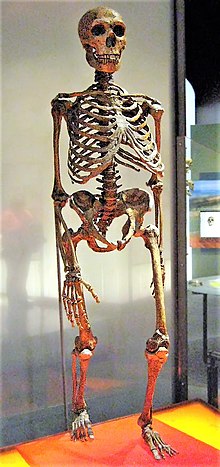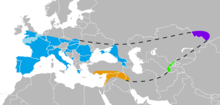Neandertal
Appearance
| Neanderthal | |
|---|---|

| |
| An approximate reconstruction of a Neanderthal skeleton. The central rib-cage (including the sternum) and parts of the pelvis are from modern humans. | |
| Sayantipiko na klasipikasyon | |
| Missing taxonomy template(pakarhayon): | Homo |
| Espesyes: | †H. neanderthalensis
|
| Ngaran binomyal | |
| †Homo neanderthalensis King,1864
| |

| |
| Known Neanderthal range inEurope(blue),Southwest Asia(orange),Uzbekistan(green), and theAltai Mountains(violet) | |
| Sinonimo[6] | |
|
Homo
Palaeoanthropus
Protanthropus
| |
AnNeanderthals(/niˈændərˌtɑːl,neɪ-, -ˌθɑːl/nee-AN-də(r)-TAHL,nay-, -THAHL;[7]Homo neanderthalensisorH. sapiens neanderthalensis), pigsusurat man bilangNeandertals,iyo an sarongextinctnaespesyeosubespesyekanarchaic humansna nakaistar saEurasyasagkod sa haros 40,000 na taon an nakaagi.[8][9][10][11]Antype specimen,Neanderthal 1,nanompongan kaidtong 1856 saNeander Valleysa presenteng aldaw na Alemanya.
Toltolan[baguhon|baguhon an source]
- ↑Error sa pag-cite: Imbalidong
<ref>tatak; mayong teksto na ipinagtao para sa reperensiya na pinagngaranan nahaeckel - ↑Schwalbe, G.(1906).Studien zur Vorgeschichte des Menschen[Studies on the pre-history of man] (in German). Stuttgart, E. Nägele.doi:10.5962/bhl.title.61918.hdl:2027/uc1.b4298459.
- ↑Klaatsch, H.(1909). "Preuves que l'Homo Mousteriensis Hauseriappartient au type de Neandertal"(in fr).L'Homme Préhistorique7:10–16.https://gallica.bnf.fr/ark:/12148/bpt6k5864483g/f25.image..
- ↑Romeo, L. (1979).Ecce Homo!: a lexicon of man.John Benjamins Publishing Company. p. 92.ISBN978-90-272-2006-6.
- ↑5.05.15.25.35.4McCown, T.;Keith, A.(1939).The stone age of Mount Carmel. The fossil human remains from the Levalloisso-Mousterian.2.Clarenden Press.
- ↑Szalay, F. S.; Delson, E. (2013).Evolutionary history of the Primates.Academic Press. p. 508.ISBN978-1-4832-8925-0.
- ↑Wells, J.(2008).Longman pronunciation dictionary(3rd ed.). Harlow, England: Pearson Longman.ISBN978-1-4058-8118-0.
- ↑Error sa pag-cite: Imbalidong
<ref>tatak; mayong teksto na ipinagtao para sa reperensiya na pinagngaranan nahigham2014 - ↑Error sa pag-cite: Imbalidong
<ref>tatak; mayong teksto na ipinagtao para sa reperensiya na pinagngaranan nahigham2011 - ↑Error sa pag-cite: Imbalidong
<ref>tatak; mayong teksto na ipinagtao para sa reperensiya na pinagngaranan napinhasi2011 - ↑Error sa pag-cite: Imbalidong
<ref>tatak; mayong teksto na ipinagtao para sa reperensiya na pinagngaranan nagalvan2014
